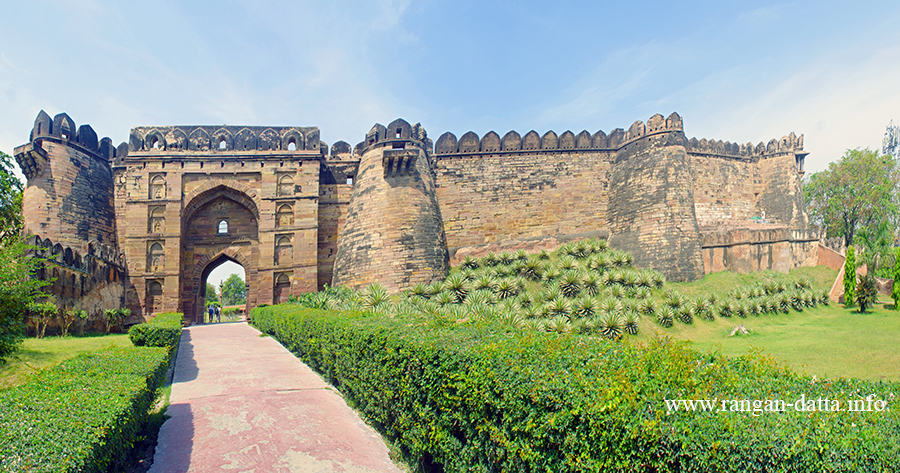A citadel on the banks of the Gomti River
A medieval-era bridge and a fort, along with half a dozen mosques with towering gateways. This is what that sleepy hamlet of Jaunpur in Uttar Pradesh has to offer. According to historical records, Jaunpur was initially under the Tughlaq dynasty.

Inner gate and rampants of Shahi Qila (Jaunpur Fort), Jaunpur
Later it gained independence and served as an independent sultanate under the Sharqi Dynasty (1394 and 1479). After which it came under the control of the Lodis followed by the Mughals.

Outer gate of Shahi Qila (Jaunpur Fort), Jaunpur
Today Jaunpur is just like any small town of India with unplanned town planning and chaotic traffic.
Several of the Sharqi and Mughal structures have survived the test of time and still tower above the modern cityscape of Jaunpur.
The medieval structures have blended with the modern cityscape and thus giving Jaunpur a unique mix of old and new.
But India is a country of diversity and blending of old and new is nothing unique in this vast country.
What makes Jaunpur unique is the mosque architecture, probably found nowhere in the country. They consist of towering ornate gateways complete with elegant calligraphy along with floral and geometric designs.

Inner gate of Shahi Qila (Jaunpur Fort), Jaunpur
Apart from the mosques, Jaunpur has several other medieval structures consisting of bridges to tombs, but the one that stands out is the Shahi Fort (or Royal Fort). Also known as Jaunpur Fort it overlooks the Gomti River.

Mosque at Shahi Qila (Jaunpur Fort), Jaunpur
The fort stands on an elevated ground on the northern bank of the Gomti River (Google map location).
The elevation had a strategic importance as it provides a bird’s eye view of the surrounding area.
The fort dates back to the Tuglaque period and was constructed by Feroz Shah Tughlaq (reign: 1351 – 88).
Later the Sharqi Dynasty made several extensions and modifications and in the process added more grandeur to the citadel.
The defensive mechanism consisted of walls and moats. The double-layered fortification wall was complete with bastions and topped with battlements. The moats have long dried up but the mighty walls and bastions still dominate the skyline of Jaunpur.

Mosque at Shahi Qila (Jaunpur Fort), Jaunpur
Today the Jaunpur Fort is a protected monument under the Archaeological Survey of India (ASI). The entrance is through the gate on the northeastern corner. The outer gate had beautiful blue fresco ornamentation but most of it had peeled off.

Hammam at Shahi Qila (Jaunpur Fort), Jaunpur
Sadly nothing much remains inside the fort. A mosque and a Turkish hammam are the only two major structures within the fort. During my visit in March 2023, both have been given a facelift. Sadly the facelift has robbed them of their antiquity.
Hammam of Shahi Qila (Jaunpur Fort), Jaunpur
The mosque dates back to 1376 and was built by Feroz Shah’s brother. It has three domes and a triple-arched entrance on the eastern side. A slender minar stands in front of the mosque. Sadly entry inside the mosque is restricted.
Inside the hammam of Shahi Qila (Jaunpur Fort), Jaunpur
The hammam, built in Turkish style, lies a short distance away from the mosque and was built during the Mughal period. There are several domes with openings allowing natural light to filter inside the hammam.

A gateway inside the Shahi Qila (Jaunpur Fort), Jaunpur
Unlike the mosque, the interiors of the hammam are accessible and consist of several rooms connected by a maze of passageways, complete with water channels for hot and cold water.

View of Jaunpur from Shahi Qila (Jaunpur Fort)
Apart from the mosque and hammam the interiors of the fort house a couple of more structures and the most prominent of them is a gateway.
Unlike the mosque and hammam it has not been given a facelift and in the process maintains its antiquity. But with no display boards, nothing can be known about the gateway.
The fort compound also houses a dargah, containing the mortal remains of some unknown sufi saint. There are also a couple of dried-up wells, which once provided water to the hammam. The entire area is well maintained with manicured lawns and flower beds, which lie in the shadows of the towering fort wall. Do climb up on one of the vantage points to get a bird’s eye view of Jaunpur.
Necessary Information:
- Timing:ASI Monument open from sunrise to sunset
- Entry fee: ₹20, payable only through UPI
- Photography: allowed
- Getting there: Jaunpur is best explored in a day trip from Varanasi (63 km) and Allahabad (102 km)
- Other attraction of Jaunpur: Jaunpur also has a number of mosques and tombs (detailed article comming soon in my blog)
The medieval citadel of Jaunpur have something more to offer beyond the Shahi Qila (Royal Fort). It consists of several mosques, tomb and a bridge.
More on:



